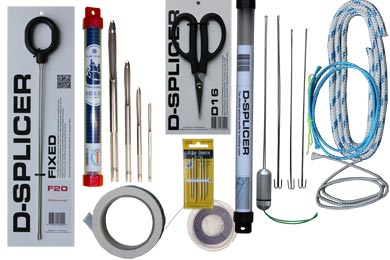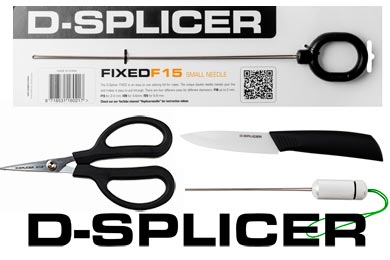Instruction videos
Want to do your own rigging and splicing of ropes? We have made more than 30 rope splicing instruction videos. For example, how to make an eye-splice in modern ropes? Or how to make soft shackles from ropes with Dyneema® fibers? Watch our video's! The reference numbers correspond to the chapters of 'Handbook Splicing Modern Ropes'.
Want to start with splicing? Check out our wide range of splicing tools . And do you already have our Rope Splicing App on your phone? All splicing instructions in your pocket and easy to use off-line!
5. Eye splice in plaited or twisted ropes
These are traditional splices. On modern sailing yachts 3-strand and 8-strand ropes are often used for splicing fender lines and mooring lines.
6. Eye splice in polyester ropes
7. Eye splice in ropes made from super fibres such as Dyneema®
Single braided ropes made from Dyneema® fibres basic method
Rope: Dinghy Race Grip
Single braided line made from super fibres such as Dyneema® or Stirotex - use when both ends are free
Rope: DX Core, DX Core 99, S Core, P Core
Double braid rope made from super fibres such as Dyneema® or Stirotex - simple method
Rope: DX Cup, DX Cup Grip, DX Performance, S Cup
Double braid line made from Dyneema® fibres-using cover
Rope: DX Cup, DX Cup Grip, DX Performance, S Cup
Download the Premium Ropes App with splicing instructions:
Apple store and Google Play
Single braided line made from super fibres such as Dyneema® or Stirotex - use when one end is attached
Rope: DX Core, DX Core 99, S Core, P Core
Double braid line made from super fibres such as Dyneema® or Stirotex - cover tucked back
Rope: DX Cup, DX Cup Grip, DX Performance, S Cup
Double braid line made from Dyneema® fibres with double cover
8. Dyneema® fibre soft shackles
9. Weight savings and tapering
Tapered Dyneeema® fibre halyard or sheet
Rope: DX Cup, DX Cup Grip
Splicing a steelwire lead to a double braid polyester
Rope: Cruiser XTS, Wire-to-rope halyards
End-to-end splice two single braid rope with Dyneema® fibres
Rope: DX Core, Dinghy Race Grip
Making a Dyneema® fibre lead
Ropes: DX Core, Cruiser XTS
10. Thickening and strengthening
If your rope does not hold in jammers or clutches, splice an extra cover or add an extra core. Chafing covers from Technora or Dyneema®are great to extend the life of your ropes.
Splice an extra cover over a rope
Need protection from chafing? Choose our Dyneema® fibre Cover.
Need better grip in clutches? Choose our Technora cover.
11. Continuous loops
Loop of double braid polyester - equal thickness
The core is not used in this splice and that leads to an equal thick rope.
However this loop is reduced in strength. E.g. use it for furlers.
Rope: Cruiser XTS
Simple Dyneema® fibre loop
Ropes: DX-Core
Loop of double braid polyester - strong,
the core is used in this loop and adds to the breaking load.
Rope: Cruiser XTS
Dyneema® fibre loop with cover- strong.
If you want a short and very strong Dyneema® fibre loop, multiply the loops in the cover
Ropes: DX Core, Dyneema® fibre cover, Dogbones
12. Whippings
Stitched whipping for double braided ropes
the core is not used in this splice and that leads to an equal thick rope.
However this loop is reduced in strength. E.g. use it for furlers.
Rope: Whipping twine
Simple whipping
Rope: Whipping twine

Rope splicing tools are available as set and separately.
We sell Selma fids and the total D-SPLICER range.
Whipping for a three-strand rope
Ropes: Whipping twine
13. Reeving new halyards
Reeving eye, also Flemish eye
Use it for reeving only as it is not a strong eye
Other methods for reeving halyards
14. Splicing tips and tricks
Not enough space in a rope: use a SoftFid!
Rope: D-Splicer SoftFid
Download the Premium Ropes Ropesplicing App and have splicing instructions available off-line: Apple store or Google Play
Splicing modern braided ropes of super fibres is quite fun and easy to learn. Premiumropes has uploaded various splicing tutorials, such as eye-splices, soft shackles, taper sheets or make a continuous furler line. Make sure you have enough space to work and an anchoring point for your rope. If you are on board, you can use a winch in case you need extra force. Choose a fid that matches the diameter of the rope, or even one that is slightly thinner. Never use pliers to pull out a fid from the rope - you will damage it! Do you know what the construction of your rope is? Check our table what splicing technique to choose for which type of rope. The core material largely determines the type of splice, whether it is core dependend or if you need to use the cover in the eye-splice too.



